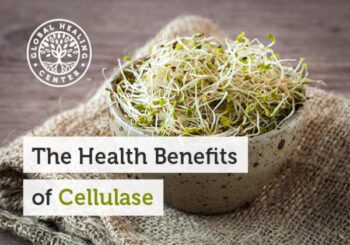Guest Writer for Wake Up World
Did you know that no animal can digest plant fiber? A large portion of a plant is fibrous, tough cellulose, which makes up its cell walls. The cell walls of fungi, including Candida, is also made of cellulose. For humans or other animals to digest plant cellulose, we need the enzyme cellulase.[1]
What Exactly Is Cellulose?
Cellulose is a complex carbohydrate and a key part of the outer cellular structure of all green plants. It is one of the most abundant compounds in the world, as it is the building block for much of the plant kingdom and is a primary food for many of the world’s living organisms.
Some creatures are much more efficient than we are at cellulose digestion. The cow, for example, has a four-chambered ruminant stomach that can hold a massive amount of cellulose-digesting microbes to break down the grass and hay that comprise such a large part of its diet. This is why cows can get big and strong from eating grass.
Similarly, if we eat lots of juicy, healthy greens, sprouts, and herbs, we want to make sure that we can digest a portion of the cellulose in them by having enough cellulase available. It would be a shame to waste the money we spend on fresh fruits and veggies and not get the full nutritional benefit they provide.
How Does Cellulase Work?
Cellulase is an enzyme that breaks down the cellulose plant fibers we eat into beta-glucose and short-chain polysaccharides. Almost all species of bacteria, fungi, and protozoa produce cellulase, but humans and animals do not. Cellulase is made up of a complex of several different enzymes, including exoglucanases (also called cellobiohydrolases), endoglucanases and beta-glucosidases.[3] These enzymes work together to allow an animal to fully break down (or hydrolyze) cellulose into the simple sugar beta-glucose.[2] This chemical process is called cellulolysis, the scientific term for the breakdown of cellulose.
Once cellulase breaks down cellulose into polysaccharides or beta-glucose, the body either uses these byproducts or expels them.[2] The rest of the plant cellulose fiber acts as a bulking agent that is eliminated in the stool.
Different microflora species produce different types of cellulases, and their activity is pH-dependent: some prefer an alkaline environment (low pH) and others are more active in an acidic (high pH) or neutral environment.
Cellulose isn’t as quickly digested as other nutrients or components of plant food. In fact, when it comes to digesting cellulose, a slower-moving digestive system is beneficial in that it will better digest cellulose than a digestive system that passes food through too quickly.[4] People, with the help of the cellulase enzyme, also digest the cellulose in different plants with different levels of success. For example, research suggests people digest the cellulose in cabbage and carrots better than cottonseed hulls.[4]
The Health Benefits of Cellulase
Cellulase enzymes may improve health in the following ways:
- Aid the breakdown of cellulose into usable glucose[2]
- Break down harmful microbial biofilms[5]
- Help fruits and vegetables release antioxidant compounds in association with pectinase enzymes[6,7
- Improve the nutritive value of fermented foods[8]
- May improve the nutritive value of whole grains[9]
In vitro studies show that the cellulase enzyme can stop the growth and increase the breakdown of biofilms produced by the bacteria Pseudomonas.[5] This may help detoxify the intestinal tract, as well as the body’s major organ systems.
Cellulase is widely used in the food industry to increase the availability of a food’s nutritional properties, from antioxidants in fruit and vegetable juice to improve nutrient retention in whole grains. Research has not yet documented whether these same properties work in vivo, or inside the body, but the industrial uses are well documented scientifically.
In one study, nursing home patients taking a multi-enzyme formula containing cellulase absorbed protein better.[10] This indicates the digestive enzymes in the nutritional formula improved digestion of the study participants, which should lead to better overall health and wellness. Other tests found an improvement in immune function for the patients. Furthermore, when the enzyme supplement was withdrawn, the positive benefits ended.
How to Read the Units of Measurement for Cellulase
Cellulase is measured in CUs, (Control Units). These units are set by the United States Pharmacopeia in accordance with the Food Chemicals Codex (FCC) – internationally recognized standards for the purity and standardization of food ingredients and supplements. In the case of enzymes, FCC uses a standard assay, or test, to accurately determine the activity of enzymes.
Where Can I Find the Best Source of Cellulase?
The product VeganZyme® contains a 100% vegan form of cellulase produced by the natural fermentation process of Trichoderma reesei and Bacillus licheniformis. It comes from non-GMO sources and is kosher certified, gluten-free, vegan, and made in the USA from globally sourced ingredients.
VeganZyme is the most advanced full-spectrum systemic and digestive enzyme formula in the world and is free from fillers and toxic compounds. This formula contains digestive enzymes, which help digest fats (lipids), sugars, proteins, carbohydrates, gluten, fruits and vegetables, cereals, legumes, bran, nuts and seeds, soy, dairy, and all other food sources. VeganZyme may also be used as a systemic enzyme blend to break down excess mucus, fibrin, various toxins, allergens, as well as excess clotting factors throughout your body.
References:
- Lynd LR, et al. “Microbial Cellulose Utilization: Fundamentals and Biotechnology.” Microbiol Mol Biol Rev. 2002;66(3),506–577.
- Koivula A. “Structure-function studies of two polysaccharide-degrading enzymes: Bacillus stearothermophilus a-amylase and Trichoderma reesei cellobiohydrolase II.” Academic Dissertation. University of Helsinki, Technical Research Centre of Finland. 1996.
- Bhat MK, Bhat S. “Cellulose degrading enzymes and their potential industrial applications..” Biotechnol Adv. 1997;15(3-4),583-620.
- Cummings JH. “Cellulose and the human gut.” Gut. 1984;25(8),805-810.
- Loiselle M, Anderson KW. “The use of cellulase in inhibiting biofilm formation from organisms commonly found on medical implants.” Biofouling. 2003;19(2),77-85.
- Kumar S. “Role of enzymes in fruit juice processing and its quality enhancement.” Advances in Applied Science Research. 2015;6(6),114-124.
- Kapasakalidis PG et al. “Effect of a cellulase treatment on extraction of antioxidant phenols from black currant (Ribes nigrum L.) pomace.” J Agric Food Chem. 2009;57(10),4342-51.
- Tamang JP, et al. “Functional Properties of Microorganisms in Fermented Foods.” Front Microbiol. 2016;7,578
- Singh A. “Enzymatic polishing of cereal grains for improved nutrient retainment.” J Food Sci Technol. 2015; 52(6),3147-57.
- Glade MJ, Kendra D, Kaminski MV Jr. Improvement in protein utilization in nursing-home patients on tube feeding supplemented with an enzyme product derived from Aspergillus niger and bromelain. Nutrition. 2001 Apr;17(4):348-50.
Originally published at Global Healing Center and reproduced here with permission.
About the author:
Dr. Edward F. Group III (DC, ND, DACBN, DCBCN, DABFM) founded Global Healing Center in 1998 with the goal of providing the highest quality natural health information and products. He is world-renowned for his research on the root cause of disease. Under his leadership, Global Healing Center earned recognition as one of the largest natural and organic health resources in the world. Dr. Group is a veteran of the United States Army and has attended both Harvard and MIT business schools. He is a best-selling author and a frequent guest on radio and television programs, documentary films, and in major publications.
Dr. Group centers his philosophy around the understanding that the root cause of disease stems from the accumulation of toxins in the body and is exacerbated by daily exposure to a toxic living environment. He believes it is his personal mission to teach and promote philosophies that produce good health, a clean environment, and positive thinking. This, he believes, can restore happiness and love to the world.
For more, please visit Global Healing Center.

If you've found value in our articles, we invite you to support the release of our brand-new book, "Gratitude Practices for Kids: A Practical Guide for Adults to Instill a Spirit of Appreciation and Positivity in the Next Generation."
"Gratitude Practices for Kids" brings together over 25 innovative and accessible practices designed to enhance gratitude in everyday life. This comprehensive guide is backed by 17 scientific studies, ensuring each concept is grounded in research, underscoring our commitment to nurturing growth, emotional intelligence, and positive interactions between adults and children.
We encourage you to opt for the paperback version to celebrate this new release. Dive into its fresh pages away from digital distractions, allowing you to immerse yourself in the transformative practices it offers.
Over recent years, Wake Up World has faced significant online censorship, which has impacted our financial ability to operate. Moving into book publishing represents a strategic step to secure the ongoing funds needed to continue our mission. By purchasing Gratitude for Kids, you help us keep our content free and accessible to everyone, avoiding needing a paywall. With over 8,500 articles published in the last 13 years, we remain dedicated to keeping our valuable content open to all.









